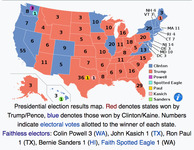 |
| Angelika/Mike Schilli |
|
Angelika We are in the middle of another election campaign. In 2015, when Trump appeared on the political stage, I still thought it was completely unthinkable that Donald Trump would ever become President of the United States. Four years later, I have to say that I fear we will probably have to brace ourselves for another term. I hope that I will be wrong again this time. Many Democratic voters are particularly frustrated with the American system of electors, because in two past elections (Bush vs. Gore and Trump vs. Clinton, see also Rundbrief 12/2000), in each case, a president made it to the White House even though the opposing candidate received more total votes from voters. Hillary Clinton received over 3 million more votes nationwide than Donald Trump, and yet Trump won. In America, it is not the direct votes of the population that count, but the electoral votes from the individual states.
Although populous states like California and Florida have more electors than sparsely populated ones, the number is determined by how many representatives the state has in the House of Representatives plus the Senate. Every state, regardless of size, sends 2 senators to the Senate, but based on population, a different number of representatives to the House of Representatives.
California, based on the last census in 2010, has exactly 53 representatives plus 2 senators, which results in California having 55 electors who vote for the president. Due to the knockout system applied in almost all states, the winner in each state receives all the electoral votes, even if the candidate wins by a narrow margin. This can lead to the described imbalance, where a candidate may receive the majority of votes nationwide but still not win. Many consider this undemocratic because ultimately not every voter's voice is considered. Furthermore, it leads to low voter turnout, as in states that always go to the candidate of the same party, the opposing side often doesn't bother to go to the polls because their vote changes nothing and is disregarded. This system also strengthens the electoral influence of states with lower population density, which in the U.S. are usually the more rural states that traditionally tend to give their votes to Republican candidates.
The Founding Fathers introduced the Electoral College as a compromise because many at the time were uneasy with the idea of the people directly electing the President and Vice President. However, they also did not want to transfer this responsibility to Congress, leading to the compromise of the Electoral College, established in "Article II, Section 1" of the American Constitution. Due to its entrenchment in the Constitution, it is not easy to get rid of the Electoral College system, as it requires a two-thirds majority in Congress.
This unusual election procedure leads to some absurdities in the campaign, such as politicians focussing on states that sometimes vote for the Republican candidate and other times for the Democratic candidate, the so-called "swing states." For example, since California has consistently voted for the Democratic candidate since 1992, no Republican candidate really campaigns there anymore.
The knockout system, in which all electoral votes go to the winner in the respective state, is not actually prescribed by the Constitution, and the states have a lot of leeway in this regard. Other models are and would be possible, such as a proportional distribution or a division based on the majority per electoral district, which is already done in the states of Nevada and Maine. Another initiative, according to which the electors give their vote to the candidate who receives the most votes on a national level, regardless of whether they won in their state or not, is currently being discussed as National Popular VoteInterstate Compact. Already, 16 states have committed or even passed corresponding laws in their respective parliaments to follow this procedure. Ultimately, this is an agreement between the states and an introduction of direct election through the back door, without having to amend the Constitution. However, for the whole thing to work at all, at least enough states would have to join the pact to reach the required majority of 270 electors. Currently, the states that have joined the pact only account for 196 electors. However, legal experts are debating whether these agreements might be unconstitutional or if approval from Congress would be needed to put the whole plan into action.
Another interesting fact is that nowhere in the Constitution does it state that electors must necessarily cast their vote for the candidate they were appointed to by the state. Theoretically, they can change their commitment and vote according to their conscience. However, individual states try to prevent this by selecting reliable and loyal electors or by imposing fines on those who deviate. A court of appeals in Denver, consisting of three judges, confirmed on August 20 that the respective states cannot force their electors to vote for a specific candidate. Many legal experts suspect that this question will ultimately be decided by the Supreme Court. Deviators are rather rare, but in the 2016 presidential elections, these so-called "Faithless Electors" caused a Democratic elector in Hawaii to vote for Bernie Sanders instead of Hillary Clinton, even though Sanders had already been eliminated in the primaries.
In the next newsletter, I will try to explain why I believe that Donald Trump will succeed again.











